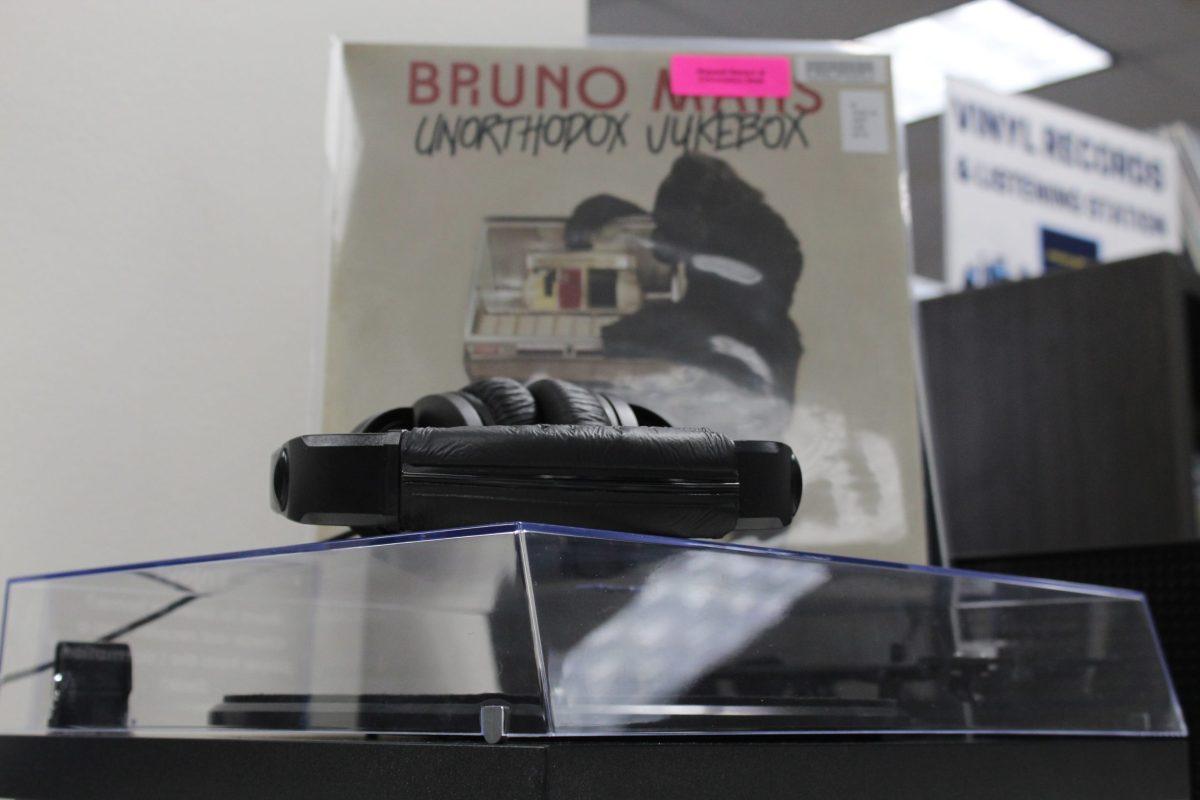The newest addition to Cowles Library – a listening station with vinyl records and turntables – is available for students to use and check out. The vinyl listening station and records are located on the main level of the library.
The vinyl station allows students to interact with media they may otherwise not have access to.
“LPs had a culture resurrection and it seemed like the perfect time to get this project rolling,” Cowles librarian Johanna Stankiewicz said in an email. “The music collection and listening station provides an opportunity for educational and personal discovery. It is one of the many services we provide at Cowles Library to provide a more inclusive and creative approach to supporting students and the educational mission of Drake.”
A turntable produces sound by reading the grooves of a vinyl record. In order to listen to a vinyl record, one must have a turntable, records and headphones, although headphones are optional. Many students are unable to listen to vinyl records unless they buy or inherit a turntable.
“If we didn’t provide a basic listening station or players for checkout, the only users able to access the collection would be ones that already know the media,” Stankiewicz said.
Allie Shambaugh-Miller, a senior studying history and sociology, has always been interested in vinyl records but viewed the experience as an extravagant expense.
“I think it’s great that they’re making it accessible to people of all backgrounds, ” Shambaugh-Miller said. “College students can experience this form of media without having to pay for it.”
Originally, the records were stored at the Dixon Media Resource Center in the Fine Arts Center.
Dr. Eric Saylor, Professor of Music History and Musicology, said that – prior to the station in the library – only faculty could check out items and students could only listen to records in the center. This was not convenient for many students, especially considering hours were limited.
“Students can’t check materials out of [FAC] because we don’t have a system like the library does that electronically tags things to keep track,” Saylor said. “We just had a very simple house system that was really just writing stuff down on a checkout sheet.”
Moving the records to Cowles allows more students to access materials and gain a unique experience. Streaming services, like Spotify, don’t allow users to listen to albums in the order intended by the artist without a premium subscription. A song is just a singular element of the whole record.
“When you listen to a record, I feel like you get a lot more immersed in the music itself,” Shambaugh-Miller said. “[It’s] how the artist intended for it to be listened to because you’re listening to every track in order.”
Records are the closest a listener can get to being in the studio with the recording artist. The record picks up all the authentic sounds happening in the studio.
“Some people would say that the quality of the recording is better on vinyl,” Saylor said. “And there is actually something to that.”
When a listener listens to music on a CD or through streaming, they are sampling. The samples are all close together, but there are gaps. Dr. Saylor compares this effect to a slow-motion camera, in which scenes have frames. Vinyl is more similar to high-speed film in that it picks up the granular details.
“CDs are less good than vinyl. Streaming is less good than CDs,” Saylor said. “So imagine the Mona Lisa going to the Louvre…you can see all the brushwork, all the depth and so on. A photograph would be one step away from that. Running that photograph through a copier is one step down from that…so it’s getting further and further and further away. That’s what happens often with these kinds of methods.”
Vinyl records also offer a charming aesthetic that is reminiscent of the past. Shambaugh-Miller said it has an essence of simplicity that forces the listener to focus on the music which creates a stronger connection.
“Getting back to the traditional way of listening to music kind of makes us feel like we are connected to the past,” Shambaugh-Miller said. “I think for a lot of people it’s nostalgia for a time that we never even experienced.”
A resurgence of vinyl records has been greatly attributed to the rise in aesthetic style. Younger generations have a desire to achieve a particular vibe, Shambaugh-Miller said.
“[The rise of vinyl] is partially because of their aesthetic,” Shambaugh-Miller said. “Record players make great decor and they look super cool.”
Cowles and the Dixon Media Resource Center will continue working together and plan to move more vinyl records and, in the future, CDs, to the library.
“If you see something you think we should have or think would support your learning, let us know and we will do our best to get it for you,” Stankiewicz said.







